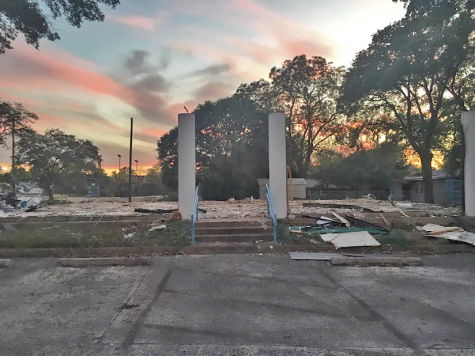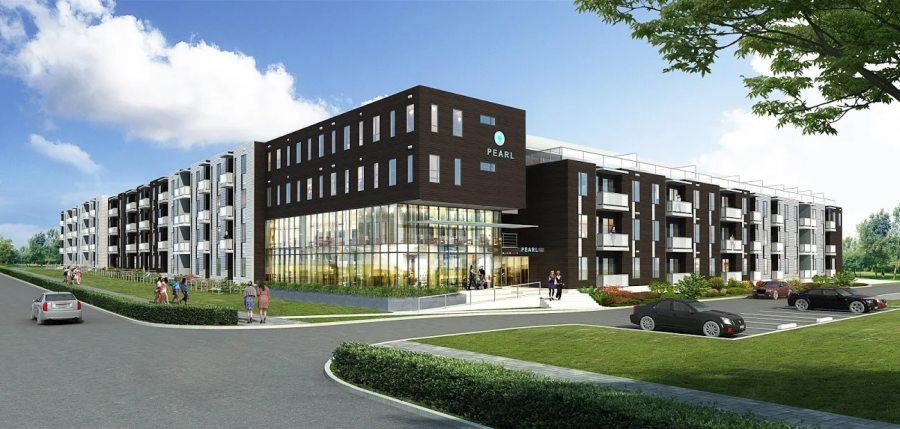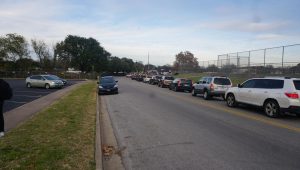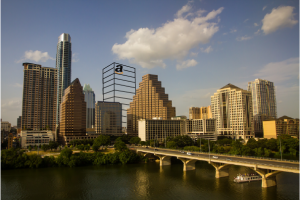From Honda store to Pearl next door
Shuttered car dealership on West Koenig makes way for apartment complex named after Janis Joplin album
Image supplied by Ian Asselstine.
A digital rendering of the new Pearl apartments, which are slated to be complete by 2020.
December 21, 2018
The Honda dealership on West Koenig Lane was frequented by many McCallum students. Some used it as their personal graffiti park, some used it to get to Thunderbird faster, and some used it as a secluded place to light up after school. Whichever of these categories you fall into, this oddly-shaped building, with its bashed-in windows and questionable homeless occupants, was likely a part of your life.
Not anymore.
In its place … apartments. In less than two years, this 5.4-acre property will be home to The Pearl, a four-story complex named after Janis Joplin’s most popular album. It will consist of 383 units, 462 parking stalls and nearly three-fourths of an acre of parks and trails.
You may have noticed a lot of apartment buildings popping up lately. That is because Austin is going through a housing crisis. Home sales are stagnant, but real estate prices get higher all the time, making owning a single-family home difficult for a lot of people. Austin Walton, an Austin citizen living in Allandale North, sympathizes with apartment renters.
“For everyone who doesn’t want apartments in central Austin: where do you suggest people live?” Walton said. “Where do you want them to go? You can’t just hang out a sign that says, ‘Austin’s full. Try again later.’”

The former First Texas Honda dealership after its recent demolition.
There is another side to this story, however. Many native Austinites are worried about how the proliferation of apartment housing will affect Austin culture. Ken Epich, who lives in Midtown, is one of those people.
“Getting excited about apartment buildings is not going to happen,” he said. “[It’s] just another nail in the coffin of Austin’s central neighborhood.”
Ian Asselstine, vice president of development at Ledcor Properties, whose job is to secure zoning and permits for The Pearl, understands his point of view.
“Austin culture is always at the forefront of our minds,” Asselstine said. “In fact, it plays a large role in the naming of our project. But Austin has a housing crisis. The demand for housing is outpacing supply, so without thoughtful, well-designed housing, the cost to live will quickly move beyond reach for some people.”
Another concern among the community surrounding The Pearl is traffic. Once finished, its tenants would add a significant amount of cars to the already busy roads in the area. There may be a solution, though.
“We did a thorough traffic analysis,” Asselstine said, “And concluded that any traffic impact could be mitigated with an adjustment to the traffic light frequencies at the lot intersections.”
There have additionally been some concerns with building code. Last year, the development lawyer David Hartman requested variances to accommodate a taller-than-normal height for the building, a taller- than-normal fence along the property line and for the building to be closer to the street than usually permitted . The variances were granted by the City of Austin Board of Adjustment on a decision sheet filed on April 10, 2017.
However you feel about The Pearl, it is coming. It could be a positive addition to the McCallum community as opposed to an old, abandoned building, or the traffic produced by it could make getting to school more difficult.
Although Ledcor says it is doing its part to keep The Pearl from negatively affecting community life, it will assuredly have some impact. Residents will have to wait and see if the positive changes outweigh the negative.









Harrison Wynn • Feb 24, 2019 at 2:27 pm
I never really gave the Honda store much attention but this story didn’t just inform me, but it also made me really feel more concern about the situation than I thought I could have. good job.
Bridget Cole • Jan 21, 2019 at 2:24 pm
This story was very informative I liked how we got to hear opinions from both sides.
Wyatt Cunningham • Jan 18, 2019 at 2:26 pm
They should have kept the Honda dealership.
grace nugent • Jan 14, 2019 at 3:29 pm
I love the investigative writing and I can definitely relate to the intro. Congrats on Best of SNO!
ale • Jan 14, 2019 at 3:19 pm
This piece was really informative. I like how it talked about both the pros and cons of The Pearl.
ale • Jan 14, 2019 at 3:17 pm
This was an extremely informative piece. I like how it talked about both the pros and cons of the pearl.